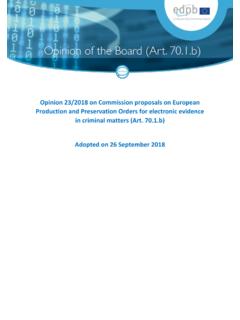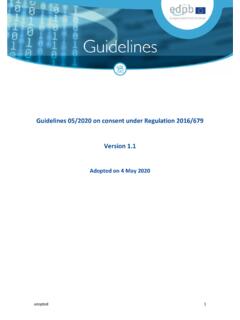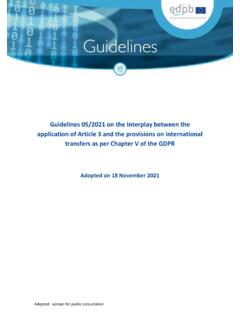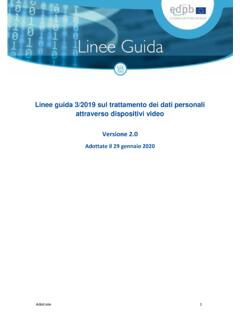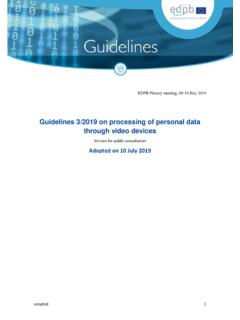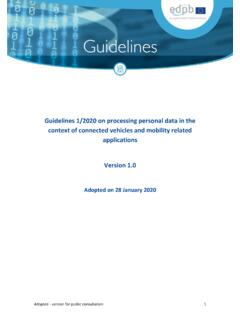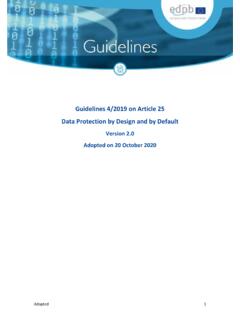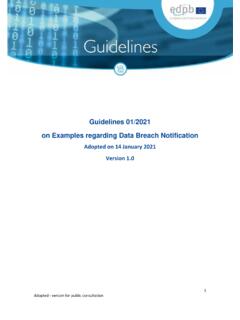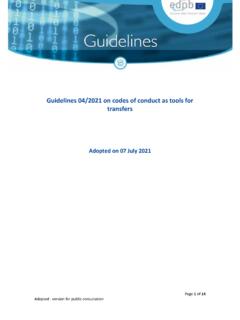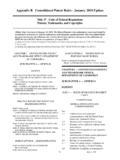Transcription of EDPB-EDPS Joint Opinion 5/2021 on the proposal for a ...
1 1 AdoptedEDPB-EDPSJ oint Opinion5/2021on the proposal for aRegulation of the EuropeanParliament andof the Councillaying down harmonised ruleson artificial intelligence(Artificial Intelligence Act)18 June 20212 AdoptedExecutive SummaryOn 21 April 2021, the European Commission presenteditsProposal for a Regulationof the EuropeanParliament and of the Councillaying down harmonised rules on artificialintelligence(hereinafter theProposal ). The EDPB and the EDPS welcome the concern of the legislator in addressing the use ofartificial intelligence (AI) within the European Union(EU)and stress that the proposal has prominentlyimportantdata protection EDPB and the EDPS note that thelegal basisfor the proposal is in the first place Article 114 of theTreaty on the Functioning of the European Union (TFEU).
2 In addition, theProposal is also based on Article16 of the TFEU insofar asit contains specific rules on the protection of individuals with regard to theprocessing of personal data, notably restrictions of the use of AI systems for real-time remote biometricidentification in publicly accessible spaces for the purpose of law enforcement. The EDPB and EDPS recallthat, in line with the jurisprudence of theCourt of Justice of the EU (CJEU), Article 16 TFEU provides anappropriate legal basis in cases where the protection of personal data is one of the essential aims orcomponents of the rules adopted by the EU legislature. The application of Article 16 TFEU also entails theneed to ensure independent oversight for compliancewith the requirements regarding the processing ofpersonal data, as is also required Article 8 of the Charterof the Fundamental Rightsof the thescope of the proposal ,the EDPB and EDPS strongly welcome the fact that it extends to theprovision and use of AI systems by EU institutions, bodies or agencies.
3 However, theexclusion ofinternationallaw enforcement cooperation from the scopeset of the proposal raises serious concernsforthe EDPB and EDPS, as such exclusion creates a significant risk of circumvention ( , third countriesor international organisations operating high-risk applications relied on by public authorities in the EU).The EDPB and the EDPS welcome the risk-based approachunderpinning the proposal . However, thisapproach should be clarified and the concept of risk to fundamental rights aligned with the GDPR andthe Regulation (EU) 2018/1725 (EUDPR), since aspects related to the protection of personal data come EDPB and the EDPS agree with the proposal when it states that the classification of anAI system ashigh-risk does not necessarily mean that it is lawfulper se and can be deployed by the user as requirements resulting from the EU data protection law may need to be compliedwithbythe controller.
4 Moreover, the compliance with legal obligations arising from Union legislation (includingonpersonal data protection) should be a precondition to being allowed to enter the European market as CEmarked product. To this end, the EDPB and the EDPS consider thatthe requirement to ensure compliancewith the GDPR and EUDPR should be included in Chapter 2 of Title addition, the EDPB andthe EDPS consider necessary to adapt the conformity assessment procedure of the proposal so that thirdparties always conduct high-risk AI systems ex-anteconformity the great risk of discrimination, the proposal prohibits social scoring when performed over acertain period of time or by public authorities or on their behalf.
5 However, private companies, such associal media and cloud service providers,alsocan process vast amounts of personal data and conduct socialscoring. Consequently,thefuture AI Regulationshould prohibit any type of social biometric identification of individuals in publicly accessible spaces poses a high-risk of intrusioninto individuals private lives, with severe effects on the populations expectation of being anonymous inpublic spaces. For these reasons, the EDPB and the EDPS call for a general ban on any use of AI for anautomated recognition of human features in publicly accessible spaces-such as of faces but also of3 Adoptedgait, fingerprints, DNA, voice, keystrokes and other biometric or behavioural signals-in any context.
6 Abanis equally recommendedonAI systems categorizing individuals from biometrics into clustersaccording to ethnicity, gender, as well as political or sexual orientation, or other grounds for discriminationunder Article 21 of the , the EDPB and the EDPS consider that the use of AI toinferemotions of a natural person is highly undesirable and should be EDPB and the EDPS welcome thedesignation of the EDPS as the competent authorityand themarket surveillance authorityfor the supervision of the Union institutions, agencies and , the role and tasks of the EDPS should be further clarified, specifically when it comes to its roleas market surveillance authority. Furthermore, thefuture AI Regulationshould clearlyestablish theindependency of the supervisory authoritiesin the performance of their supervision and designation ofdata protection authorities (DPAs)as the national supervisory authorities would ensurea more harmonized regulatory approach, and contribute to the consistent interpretationof data processingprovisions and avoid contradictions in its enforcement among Member States.
7 Consequently, the EDPBand the EDPS consider thatdata protection authorities should be designated as national supervisoryauthorities pursuant to Article 59 ofthe proposal assigns a predominant role to the Commission in the European Artificial Intelligence Board (EAIB). Such role conflicts with the need for an AI European bodyto beindependent from any politicalinfluence. To ensure its independency, thefuture AI Regulationshould givemore autonomy to the EAIBand ensure it can act on its own the spread of AI systems across the single market and the likelihood of cross-border cases,there is a crucial need for a harmonized enforcement and a proper allocation of competence betweennational supervisory authorities.
8 The EDPB and EDPS suggest envisaginga mechanism guaranteeingasingle point of contact for individuals concerned by the legislation as well as for companies, for eachAI thesandboxes,the EDPB and the EDPS recommend clarifying their scope and proposal should also clearly statethatthelegal basis of such sandboxes should comply with therequirements established in the existing data protection systemoutlined inthe Proposalismissing a clear relation to theEUdata protectionlawas well astoother EU and Member States law applicable to each area of high-risk AI systemand isnot taking intoaccount theprinciples of data minimization and data protection by designas one of theaspects to take into considerationbefore obtaining the CE marking.
9 Therefore, the EDPB andthe EDPS recommend amending the proposal as to clarify the relationship between certificates issued under the saidRegulation and data protection certifications, seals and marks. Lastly, theDPAsshould be involved in thepreparation and establishment ofharmonized standards and common thecodes of conduct,the EDPB and the EDPS consideritnecessaryto clarifyif the protectionof personal data is to be considered among additional requirements that can be addressed by thesecodesof conduct, and to ensurethatthe technical specifications and solutions do not conflict with the rules andprinciples of the existingEUdata protection OF OF THE KEY PRINCIPLES OF THE of the proposal and relationship with the existing legal uses of AI for anex-anteconformity assessment by external third of regulation must also cover AI systems already in and European AI AI WITH THEDATA PROTECTION of the proposal to the existing EU data protection & further processing (Articles 53 and 54 of the proposal ).
10 Of special categories of data & data relating to criminal European Data Protection Board and the European Data Protection SupervisorHaving regard to Article 42(2) of the Regulation(EU)2018/1725 of 23 October 2018 on theprotection of natural persons with regard to the processing of personal data by the Unioninstitutions, bodies, offices and agencies and on the free movement of such data, and repealingRegulation (EC) No 45/2001 and Decision No 1247/2002/EC1,Having regard to the EEA Agreement and in particular to Annex XI and Protocol 37 thereof,as amended by the Decision of the EEA Joint Committee No 154/2018 of 6 July 20182,Having regard to the request for a Joint Opinion of theEuropean Data Protection Supervisorand of the European Data Protection Board of 22 April 2021 regarding the proposal for aRegulation laying down harmonised rules on artificial intelligence (Artificial Intelligence Act),HAVE ADOPTED THE FOLLOWING Joint advent of artificial intelligence( AI )
